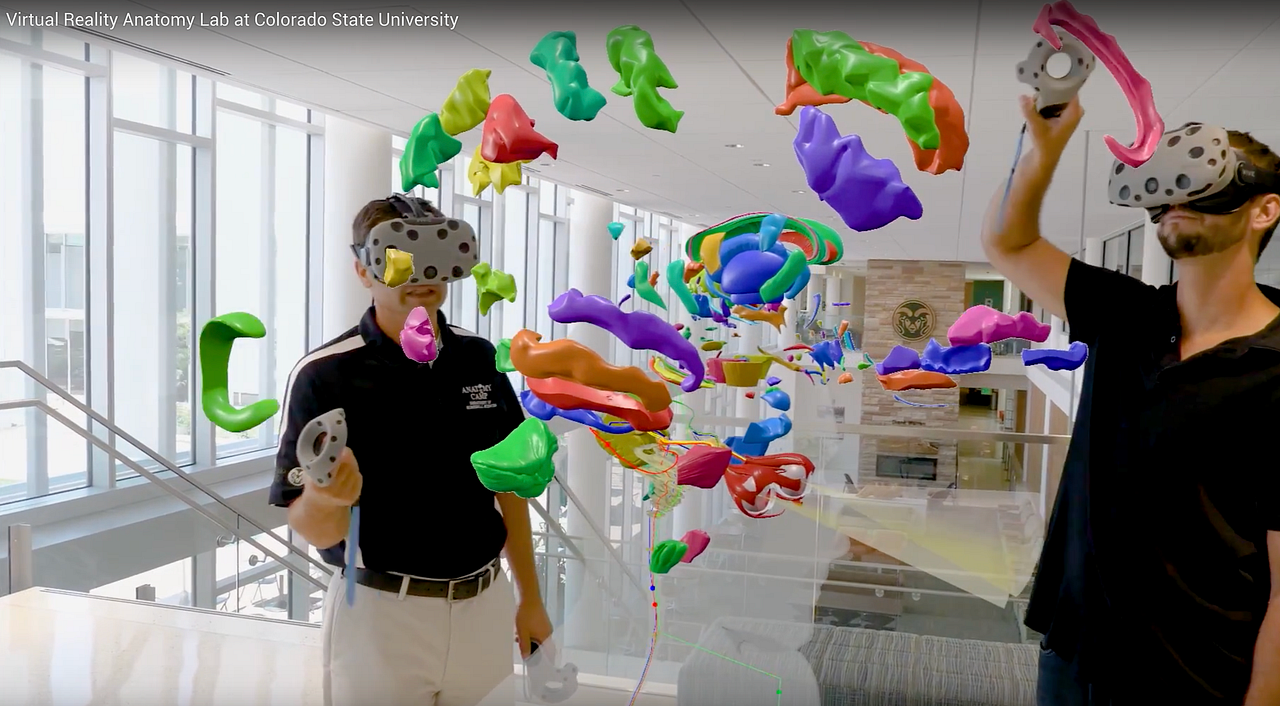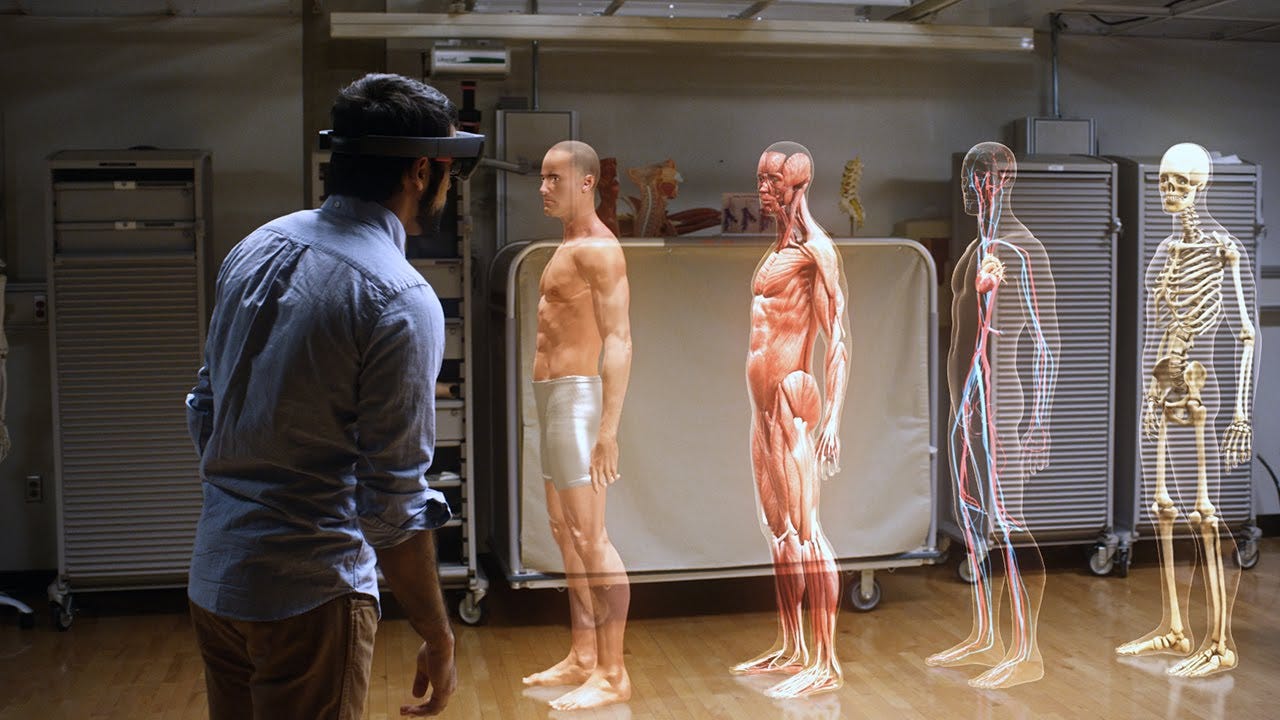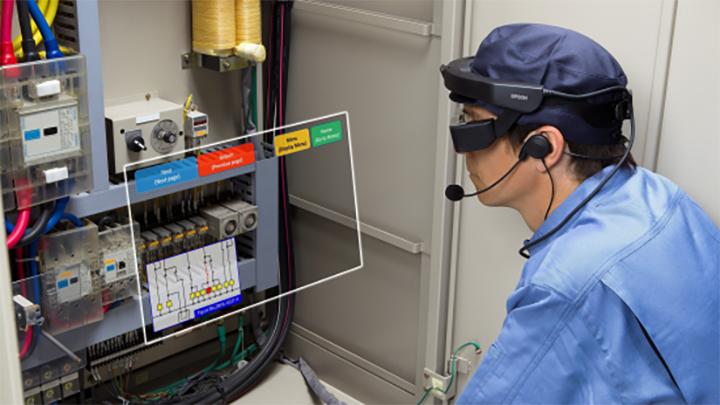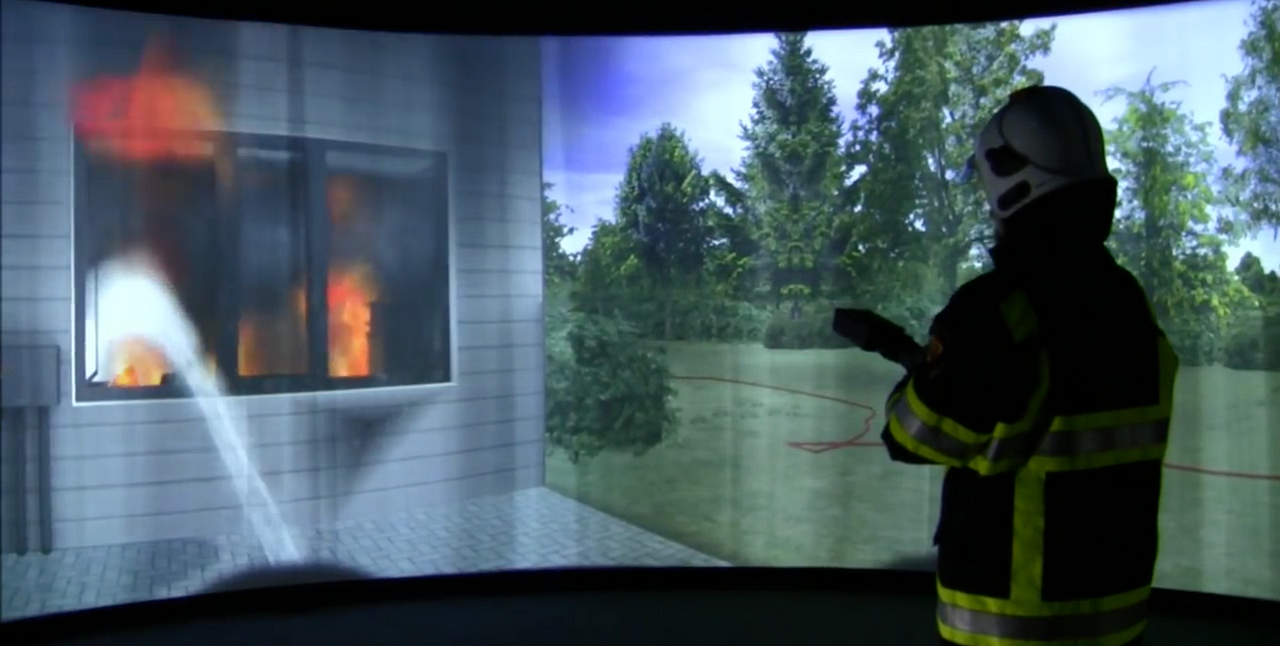Augmented and Virtual Reality in Education — Part 2: Higher Ed
Augmented and Virtual Reality in Education — Part 2: Higher Ed
- Last Updated: December 2, 2024
Scottie Gardonio
- Last Updated: December 2, 2024



In Augmented and Virtual Reality in Education — Part 1: K-12, we looked at how AR/VR can supplement lesson plans to provide children with better, more educational experiences in school.

Now, we’re off to the dorms with college-ruled notebooks and the best space-saving furniture on the market to take a look at augmented and virtual reality in higher education.
Whether a student is a freshman or a sixth-year senior, the start of a new college semester can be both exciting and intense. This is, ultimately, where students begin to forge their own paths in newly-independent lives. They’re making lasting choices and concentrating their studies to form career paths — both of which make a mind-sponge bloat with knowledge.
This all comes at a price, though, as higher education is often associated with loans and expenditures. While this is hardly the place to have any sort of tuition-based debate, it is likely agreed that when a person pays for schooling, that person will expect to get as much “bang for his/her buck” as is possible.
Enter AR and VR
As seen in Part 1 of this educational series, AR/VR offer solutions to some of the gaps we find in educational systems. When we apply the same augmented and virtual technologies in higher education settings, we can further see why these invaluable tools will better prepare students for their upcoming careers.
As they say, the proof is in the pudding, so let’s look at some examples.
Before we do, though, can we take a moment to look at the oddity of the above idiom? Every time I hear this, I think of some lawyer in a courtroom. He defends his client by simply saying, “the proof is in the pudding,” and then hands out Kraft pudding cups. Judge and jurors proceed to frantically dig through the goop with plastic spoons to find said proof.
Anyway, let’s venture back to college since we’re already late for class.
Lawyers, Libraries, & Books (oh, my)
Since lawyers and courtrooms are now on the mind, let’s focus on how augmented and virtual reality might play a vital role in that type of education.
Though I cannot profess to be a brilliant legal mind, I do recall a college course where a professor described the disparity between how trials are portrayed in cinema and how they play-out in real life. He went so far as to tell us how he knew of another professor who showed the end court scene from A Few Good Men as a means to illustrate how passion can play a role at a trial.

Image Credit: Columbia Pictures
Legal students spend endless hours pouring through laws and court cases in an effort to learn and educate themselves on history and precedents. History-making trials are taught to show how certain laws came about, but this is, for the most part, only studied through the written word. This type of study cannot likely be taken away, but what if we could supplement it with the ability to go to the courtroom and see the actual trial as it took place?
The ability to do so, by way of virtual reality, is helpful in teaching exactly how cases were presented, not just the succinct dictation and then recorded aftermath. Additionally, the included situational visuals are proven to assist in memory creation that can then be easier to draw upon at a later date.
Books & Resources
When it comes to law school, though, it’s hard not to think of the endless stacks of books required for a student to round out his/her education.
Endless stacks hold intertwining information from which each student is required to patch together information. But, what if your chosen state school doesn’t have as many books at its disposal as that super-elite university down the road?
Well, what if you had access to a virtual library? Stick on your school-monitered VR headset and travel to the world’s most comprehensive grouping of books. Here, you have access to everything you need.
No other student checked it out three weeks ago, never to be returned. You and your classmates aren’t all clamoring to review the same two copies as you all prepare for the same tests. You even have access to out-of-country texts assisting in further study without today’s libraries spacial constraints.
Knimbus, a company boasting e-libraries, is already making this leap by allowing educational institutes to build customizable virtual libraries.
We may even see the days of hauling 142 pounds of books from lecture hall to lecture hall evaporate from our memories. Instead, activate the proper book on your AR device and the appropriate page or reference can be overlaid in front of you as you sit during class.
Medical
It’s easy to imagine anything in the medical and anatomy fields implementing and benefiting from augmented and virtual reality. So much so, in fact, that we are already seeing colleges utilizing the tools as they are created.

Image Credit: Colorado State University
The Virtual Reality Anatomy Lab at Colorado State University explains anatomy as being very spacial, and utilizing VR allows students to learn the subject matter in a more in-depth way.
Up until recently, the only way for a student, or anatomy-junkie, to learn about the working parts of a physical body was by way of text and diagrams or cadavers. Living bodies can only be produced in real medical situations when schooling is further along than the initial, memorization-based classes.
Now, however, students are being provided opportunities to dissect and inspect organs, bones, tissues, and their links in new and more efficient ways without the need to smell formaldehyde while dismantling a frog.
When viewing diagrams, the challenge is always trying to convert a two-dimensional drawing into a three-dimensional object within our own minds.
Cadaver labs offer this in real life, but this option also comes with its own challenges. The labs require dedicated space, the donation of cadavers must happen at a reasonably predictable rate, and the cadavers, themselves, have shelf-lives. Additionally, each student will get a different experience, since no two cadavers will arrive with identical medical histories. Then, once expended, new cadavers must be found.
When it comes to VR, however, we can better provide identical, more efficient, and less costly learning options.

Microsoft’s HoloLens partners with Western Reserve University. Image Credit: Microsoft
Augmented reality provides similar benefits in medical-based education. The difference is largely between how AR and VR differ. While virtual reality, and the above Colorado State University example insert the user into a new virtual environment, augmented reality, as seen in this Western Reserve University example, allows a student to stay within his/her classroom for the lesson.

Image courtesy
Engineering
Engineering is another easy sell in the virtual and augmented spaces. When an entire subject matter is dependent on the ability to produce two-dimensional designs, often based off of mathematical calculations, which are meant to seamlessly convert into three-dimensional, functional items, any assistance in the process is beneficial.
Programs, such as CAD, are often utilized to help students test and visualize the items they create. And, despite CAD being a useful tool to help one find problems or determine the worthiness of a given item, this is still only a simulation of three-dimensions.
Our eyes see a flat object on a screen, and we can twist and turn it, but our brain is still required to convert the the 2-D to 3-D. We cannot call CAD imagery 3-D anymore than we can call a human on a TV the same.
Both virtual and augmented reality offer solutions to this, however. With these technologies, the 3-D can become true. Students testing equations and designs can hold, walk around, and manipulate their creations, often at life-size. This makes the ability to see flaws at scales that will be true to the final products, and it also provides the means to physically engage with products as is intended upon production.

The Arts
In nearly every area of education, creation is taught on the shoulders of the past. Perhaps more than most, the arts, whether it be painting, music, theatre, or writing, find themselves in this position.
Studying “the greats” in any art field is instrumental for learning concepts and honing one’s craft. Whether you’re learning about Van Gogh, studying Beethoven’s creation process, or trying to divine Sylvia Plath’s inspiration, all further the next generation’s creations.
However, it is very difficult to learn about the full scale of Michelangelo’s Sistine Chapel through books, photos, or even documentaries. Being told the project was an immense effort taking years to tackle, regardless of how many sources agree, is a sad substitute for standing in the space and seeing the immensity for oneself.
Virtual reality will allow students to experience these spaces as if they were there, but at much less cost than a timely and expensive trip. And, while I can hardly state virtual reality can truly replace a real-life adventure to see some of history’s best, it is an invaluable option for students who cannot make such a trip.
The same is true for all other art-related fields of study. Instead of a student studying Bach’s Fugue in G Minor by way of only recordings, perhaps it is beneficial for a student to sit at an organ with an AR wearable at his/her disposal.
In this scenario, an augmented reality overlay allows the student learning the piece to see the keys depressing as the music progresses, better connecting the creation and product.

Image courtesy
Whether it’s allowing a student to play alongside the Philharmonic, travel to a location which inspired an important literary piece, or overlaying historic symbolism on a work for study, both AR and VR are destined to become a crucial tool in the education of our future creators.

Trade Schools
It’s time to pack up our dorm rooms for a moment, as we’re making a career change and enrolling in a trade school.
There is a whole classification of physically-based careers taught to a slew of students all hoping to keep their digits and limbs intact for as long as possible. While it is not always the case that trade schools teach solely potentially-dangerous subject matter, there are quite a few fields where this is the case.
(Yes, the below examples may also be found at university levels, but for the sake of categorization of primarily hands-on trades, they’ve been put here.)
Electricians
Take electrical engineering as an example. I, for one, would prefer to learn the ins and outs of the basics prior to electrocuting myself. It is, of course, true that current curriculums have safety in mind. However, when tools come about that will allow students a more hands-on experience in a safe environment, then students and instructors, alike, are able to feel more confident when moving toward real-life applications.
By way of “reality” programs, a student may completely wire a new house without needing a physical home in which to do so. Imagine needing a new home for each student, and for each to learn similarly, these homes would need to be identical.
That idea is preposterous until we utilize a virtual reality home which can be reset at will, or perhaps we have a real in-progress building which utilized augmented reality, instead. Both new options save time, resources, and money while providing students with a better learning opportunity.
ATC
Air traffic control is another great example of how virtual and augmented reality could be useful in training. If you’ve ever watched an episode of Air Disasters, you’ve seen how appropriate responses from a human in a tower can literally be the difference between the life and death of an entire occupancy of an aircraft.
Certainly, a variety of unfortunate scenarios are put forth toward the students in order to educate on potentially disastrous results, but there is a difference between seeing a fake crash on a radar and seeing one outside the windows of your tower.
Not all controllers work with aircraft they can physically see, of course, but for those who do, life-like simulations by way of augmented or virtual reality can help legitimize the lessons and future orders they give to pilots.
Firefighters
You’ve got your nearly fifty pounds of gear on, and you’re plowing into a burning building as a training exercise. The dense smoke and radiating heat fill your field of view, and you’re trying to make sure you save all the living beings while managing the blaze.
In many cases, this training can only go so far. Facilities are unable to manipulate the buildings to house different layouts, and in order for real fire to take place, abandoned or forefit buildings must be acquired.
If we implement a virtual or augmented reality exercise, though, there are near limitless scenarios to be used to ensure the safety of our local heros when they are forced into dangerous situations.

Virtual reality can allow for students to enter a virtual blaze, but augmented reality can allow the blaze to be placed over an existing home, creating a more life-like experience.
With both, scripts might be taken from actual fire situations which previously produced harmful outcomes, from which others can now learn appropriate courses to take should the same situation arise in the future.
Other, potential deadly scenarios, such as backdrafts and compromised ceilings/floors, can be executed and shown in ways not previously available since the danger of just teaching such things in real life proposes safety concerns.

ADMS-Fire simulation video
Thankfully, this type of training is not a future fantasy. Companies, such as ADMS-Fire are already utilizing virtual reality in training. The program the Royal Australian Navy utilizes even simulates heat in specialized suits.
Testing
Test scenarios could, potentially, evolve as well. Entire situations could be imposed upon students to fully assess their skills in less-than-perfect situations. Perhaps you have an electrician attempting to work in a flood-based situation. Or, maybe you test a firefighting student’s ability to prioritize by putting helpless victims in separate fire-laden rooms.
Real-world, dangerous scenarios can now be taught in safe environments via augmented and virtual reality. Utilizing these in training helps instructors, students, and future civilian bystanders a better chance for positive outcomes.
Countless other examples of educational utility exist. For just about every advanced field of study, AR/VR become instruments of learning. Based on just the handful of cases above, you can imagine how the same technology can be aid in the education of future chefs, carpenters, teachers, historians, athletes, mechanics, scientists… the list goes on.
We are entering a new era in higher education. Tools created on the backs of the previous graduating classes are making the educational system even more useful than previously seen. By providing virtual and augmented reality resources to students, colleges and universities are providing even more opportunities for their graduates to excel and success upon graduation.
Check out Part 3 of the Augmented and Virtual Reality in Education series where we explore the opportunities of the “new” online classrooms. In the meantime, check out the current state of AR & VR technology, as well as AR & VR in Retail, and Travel & Tourism.
The Most Comprehensive IoT Newsletter for Enterprises
Showcasing the highest-quality content, resources, news, and insights from the world of the Internet of Things. Subscribe to remain informed and up-to-date.
New Podcast Episode

Moving Past the Pilot Phase in IoT and AI
Related Articles
Are We Running Out of Infrastructure Capacity? What IoT Leaders Need to Know
December 18, 2025

Clarity Wins: What the Blue Jays’ World Series Run Teaches Tech Leaders About Alignment and Execution
October 24, 2025

The 7 Worst Examples of IoT Hacking and Vulnerabilities in Recorded History
October 3, 2025
